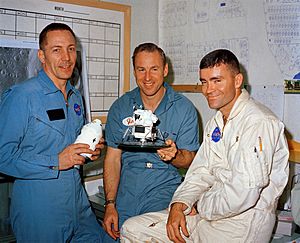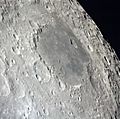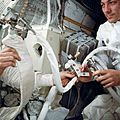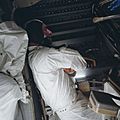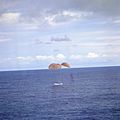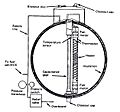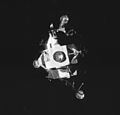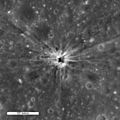Apollo 13 facts for kids
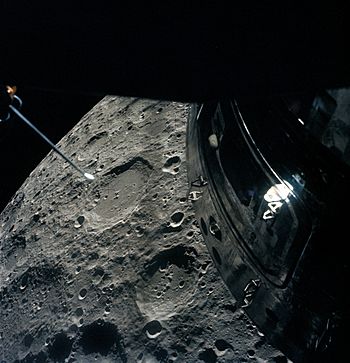
The Apollo 13 crew took this photo of the Moon from the Lunar Module.
|
|
| Mission type | Manned lunar landing attempt |
|---|---|
| Operator | NASA |
| Mission duration | 5 days, 22 hours, 54 minutes, 41 seconds |
| Spacecraft properties | |
| Spacecraft |
|
| Manufacturer |
|
| Launch mass | 101,261 pounds (45,931 kg) |
| Landing mass | 11,133 pounds (5,050 kg) |
| Crew | |
| Crew size | 3 |
| Members | |
| Callsign |
|
| Start of mission | |
| Launch date | April 11, 1970, 19:13:00 UTC |
| Rocket | Saturn V SA-508 |
| Launch site | Kennedy LC-39A |
| End of mission | |
| Recovered by | USS Iwo Jima |
| Landing date | April 17, 1970, 18:07:41 UTC |
| Landing site | South Pacific Ocean 21°38′24″S 165°21′42″W / 21.64000°S 165.36167°W |
| Orbital parameters | |
| Reference system | Geocentric |
| Regime | Cislunar |
| Flyby of Moon (orbit and landing aborted) | |
| Closest approach | April 15, 1970, 00:21:00 UTC |
| Distance | 254 kilometers (137 nmi) |
| Docking with LM | |
| Docking date | April 11, 1970, 22:32:08 UTC |
| Undocking date | April 17, 1970, 16:43:00 UTC |
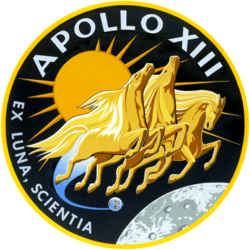 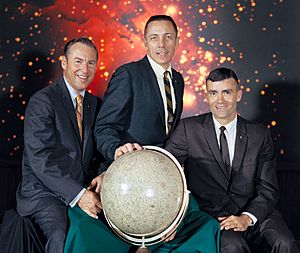 Left to right Lovell, Swigert, Haise, 12 days after their return. |
|
Apollo 13 was a space mission by NASA, part of the Apollo program. It was the seventh mission and the third time astronauts tried to land on the Moon. The crew included Commander Jim Lovell, Jack Swigert, and Fred Haise.
The spacecraft launched successfully towards the Moon. However, two days later, an oxygen tank exploded. This damaged the Service Module, causing a big loss of oxygen and electricity. The astronauts were in great danger. They needed oxygen not just to breathe, but also to make electricity. To save their air, they turned off almost all their equipment, including heaters. It became very cold inside the spacecraft.
To survive, the astronauts had to move into the Apollo Lunar Module. They used it as a "lifeboat" to stay alive. As they neared Earth, they worried if their parachutes would work. Parachutes slow down the Command Module for a safe landing. Small explosive charges, powered by batteries, release the parachutes. The extreme cold could have made the batteries fail. If that happened, the Command Module would hit the ocean too fast, which would be deadly.
The Astronauts of Apollo 13
The commander of Apollo 13 was Jim Lovell. He was 42 years old during this flight. This was his fourth and final space mission. Lovell had been a pilot in the Navy and a test pilot. He was chosen as an astronaut in 1962. He flew on Gemini 7 and Gemini 12. He also flew on Apollo 8, which was the first spacecraft to orbit the Moon. Before Apollo 13, Lovell had spent more time in space than any other NASA astronaut.
Jack Swigert was the pilot of the Command Module. He was 38 years old. He had degrees in mechanical engineering and aerospace science. Swigert was a test pilot before becoming an astronaut in 1966.
Fred Haise was the pilot of the Lunar Module. He was 35 years old. He had a degree in aeronautical engineering. Haise was a Marine Corps fighter pilot and a research pilot for NASA. Apollo 13 was the only spaceflight for both Swigert and Haise.
The Apollo 13 Flight
Apollo 13 launched on April 11, 1970, from Cape Canaveral. It first went into a temporary orbit around Earth. Two hours later, the rocket fired again to head towards the Moon. The plan was to land at a place called Fra Mauro.
Despite all the problems, the crew made it back to Earth safely. Even though they did not land on the Moon, this flight became very famous.
Some people thought the mission was a failure because the astronauts did not land on the Moon. However, many others saw it as one of NASA's greatest achievements. They managed to bring three astronauts back home safely in a very damaged spacecraft.
Before returning to Earth, there was a concern that the electrical equipment would short circuit. This was because water from the astronauts' breath had turned into liquid inside the cold spacecraft. Luckily, the electronics worked perfectly.
Books have been written about this amazing event. Jim Lovell, the mission commander, wrote one himself. A movie was also made about the mission. It was directed by Ron Howard and starred Tom Hanks.
Related pages
Images for kids
-
Mission Operations Control Room during the TV broadcast just before the Apollo 13 accident. Astronaut Fred Haise is shown on the screen.
-
CSM-109 Odyssey in the Operations and Checkout Building
-
The Apollo 13 crew photographed the Moon out of the Lunar Module.
-
Swigert with the rig improvised to adapt the CM's lithium hydroxide canisters for use in the LM
-
Nobody believes me, but during this six-day odyssey we had no idea what an impression Apollo 13 made on the people of Earth. We never dreamed a billion people were following us on television and radio, and reading about us in banner headlines of every newspaper published. We still missed the point on board the carrier Iwo Jima, which picked us up, because the sailors had been as remote from the media as we were. Only when we reached Honolulu did we comprehend our impact: there we found President Nixon and [NASA Administrator] Dr. Paine to meet us, along with my wife Marilyn, Fred's wife Mary (who, being pregnant, also had a doctor along just in case), and bachelor Jack's parents, in lieu of his usual airline stewardesses.
-
President Richard Nixon awarding the Apollo 13 astronauts the Presidential Medal of Freedom
-
The Apollo 13 command module Odyssey on display at the Cosmosphere in Hutchinson, Kansas
-
The "mailbox" at Mission Control during the Apollo 13 mission
See also
 In Spanish: Apolo 13 para niños
In Spanish: Apolo 13 para niños


